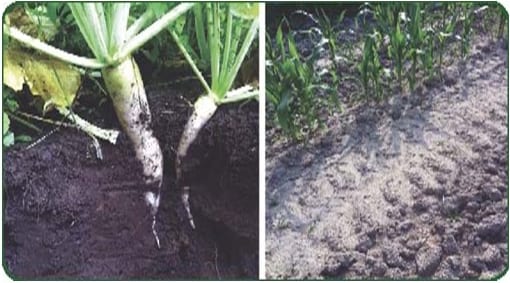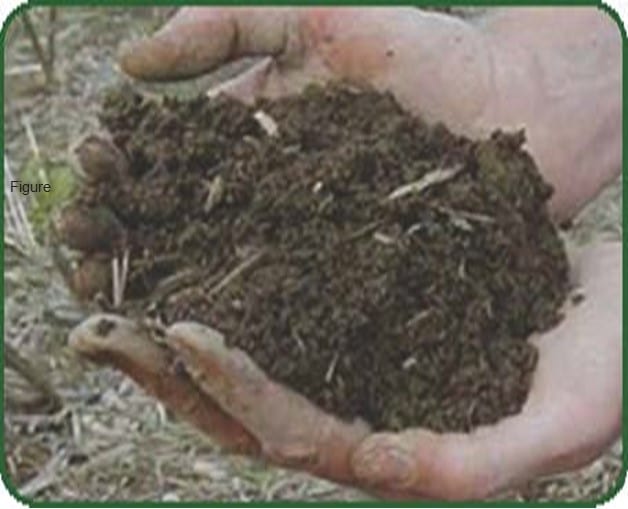by Robert Schindelbeck, Aaron Ristow, Kirsten Kurtz, Lindsay Fennell, and Harold van Es
Adapted from Cornell University Comprehensive Assessment of Soil Health Laboratory Soil Health Manual Series, January 2017. Schindelbeck, R.R., A.J. Ristow, K.S. Kurtz, L.F.Fennell, H.M. van Es.
The terms ‘soil health’ and ‘soil quality’ are becoming increasingly familiar worldwide. A modern consensus definition of soil health is “the continued capacity of the soil to function as a vital living ecosystem that sustains plants, animals and humans” (USDA-NRCS, 2012).
In general, soil health and soil quality are considered synonymous and can be used interchangeably, with one key distinction conceptualized by scientists and practitioners over the last decades: soil quality includes both inherent and dynamic quality.

Figure 1. Dynamic soil quality – beneficial vs. unfavorable management. Both photos are inherently the same Buxton silt loam. Left – Management for improved soil health: tillage radish growing in long-term pasture/hay with occasional annual crops. Right – Intensive management leading to soil degradation: long-term annual tillage and vegetable production without cover crops or other organic inputs. Due to management differences, soil health has diverged significantly.
Inherent soil quality relates to a soil’s natural composition and properties influenced by geologically long-term actors and processes including the type of parent material, topography, organisms, climate, and time. Changing just one of the factors will produce a different soil. Inherent soil quality cannot generally be influenced by human activity.
In contrast, dynamic soil quality, which is equivalent to soil health, refers to soil properties that transform as a result of soil use and management over the human time scale. (Fig. 1).
Soil health invokes the idea that soil is an ecosystem full of life that needs to be carefully managed to regain and maintain the ability to function optimally.
Important soil functions related to crop production and environmental quality:
- Retaining and cycling nutrients
- Supporting plant growth
- Sequestering carbon
- Allowing infiltration, and facilitating storage and filtration of water
- Suppressing pests, diseases, and weeds
- Detoxifying harmful chemicals
- Supporting the production of food, feed, fiber, and fuel
When the soil is not functioning to its full capacity, sustainable productivity, environmental quality, and net farmer profits are jeopardized over the long term. Impaired function may result from constraints to specific and interacting soil processes. Below are some examples of the economic benefits of maintaining and improving soil health:
- Better plant growth, quality, and yield
- Reduced risk of yield loss during periods of environmental stress (e.g., heavy rain, drought, pest or disease outbreak)
- Better field access during wet periods
- Reduced fuel costs by requiring less tillage
- Reduced input costs by decreasing losses, and improving use efficiency of fertilizer, pesticide, herbicide, and irrigation applications.

Figure 2: Good soil tilth: Zone tillage for 10 years increased organic matter compared to conventional tillage.
Characteristics of a Healthy Soil
Good soil tilth
Soil tilth refers to the overall physical character of the soil in the context of its suitability for crop production. Soil with good tilth is crumbly, well structured, dark with organic matter, and has no large and hard clods (Fig 2).
Sufficient depth
Sufficient depth refers to the extent of the soil profile through which roots are able to grow to find water and nutrients. A soil with a shallow depth as a result of a compaction layer or past erosion is more susceptible to damage in extreme weather, thus predisposing the crop to flooding, pathogen attack, or drought stress.
Good water storage and good drainage
During a heavy rain, a healthy soil will take in and store more water in medium and small pores, but will also drain water more rapidly from large pores. Thus, a healthy soil will retain more water for plant uptake during dry times, but will also allow air to rapidly move back in after rainfall, so that organisms can continue to thrive.
Sufficient supply, but not excess of nutrients
An adequate and accessible supply of nutrients is necessary for optimal plant growth and for maintaining balanced cycling of nutrients within the system. An excess of nutrients can lead to leaching and potential ground water pollution, high nutrient runoff and greenhouse gas losses, as well as toxicity to plants and microbial communities.
Small population of pathogens and pests
Plant pathogens and pests can cause diseases and damage to the crop. In a healthy soil, the population of these organisms is low or is less active. This could result from direct competition from other soil organisms for nutrients or habitat, etc. In addition, healthy plants are better able to defend against a variety of pests.
Large population of beneficial organisms
Soil organisms help with cycling nutrients, decomposing organic matter, maintaining soil structure, biologically suppressing plant pests, etc. A healthy soil will have a large and diverse population of beneficial organisms to carry out these functions and thus help maintain a healthy soil status.
Low weed pressure
Weeds compete with crops for water and nutrients that are essential for plant growth. Weeds can block sunlight, interfere with stand establishment and harvest and cultivation operations, and harbor disease causing pathogens and pests.
Free of potentially harmful chemicals and toxins
Healthy soils are either devoid of excess amounts of harmful chemicals and toxins, or can detoxify or bind such chemicals. These processes make these harmful compounds unavailable for plant uptake, due to the soil’s richness in stable organic matter and diverse microbial communities.
Resistance and resilience to degradation
A healthy, well aggregated soil, is resilient, full of diverse organisms and is more resistant to degradation from wind and rain erosion, excess rainfall, extreme drought, vehicle compaction, disease outbreak, and other potentially damaging influences.
For a more comprehensive overview of soil health concepts including a guide on conducting in-field qualitative and quantitative soil health assessments, please download the Cornell Soil Health Manual at bit.ly/SoilHealthTrainingManual.
***
Each author appearing herein retains original copyright. Right to reproduce or disseminate all material herein, including to Columbia University Library’s CAUSEWAY Project, is otherwise reserved by ELA. Please contact ELA for permission to reprint.
Mention of products is not intended to constitute endorsement. Opinions expressed in this newsletter article do not necessarily represent those of ELA’s directors, staff, or members.

